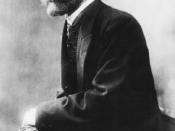There are many different theories surrounding suicide. This essay shall briefly describe Durkheim's Sociological Theory of suicide and Freud's Psychoanalytic Theory. Psychological autopsies shall then be discussed which have contributed to Shneidman's shared characteristics of suicide. Suicide victims and prevention will also be discussed.
Durkheim's Sociological Theory of suicide identifies three different types of suicide - egoistic, altruistic and anomic. Egoistic suicide victims feel that they have too few ties to society and community. They feel alienated from others and cut off from the social supports that are important to keep them functioning adaptively as social beings. Altruistic suicides are responses to societal demands. Individuals feel part of a group and sacrifice themselves for what they take to be the good of society. Some altruistic suicides are literally required as the only honourable recourse in the circumstances. Anomic suicide is triggered by a sudden change in a person's relation to society.
Anomie can pervade society in disequilibrium, making suicide more likely.
Freud's psychoanalytic theory of suicide had two major hypotheses. The first being his theory of depression which basically views suicide as murder. The second being based on thanatos, the death instinct. Freud identified that normal individuals can control their death instinct and direct it outward. Suicidal individuals on the other hand may turn this death instinct inwards which could result in the individual taking their own life.
A psychological autopsy is an investigation into the death of an individual which is usually a suspected suicide. Psychological autopsies were pioneered at the Los Angeles Suicide Prevention Centre. It involves analyzing information from crisis phone calls and interviews with relatives and friends of those who are thinking about suicide or those who are believed to have committed the act. The purpose of the autopsy is to determine the actual...



Interesting.
This's really an interesting issue.
0 out of 1 people found this comment useful.